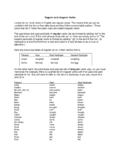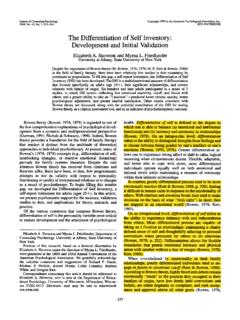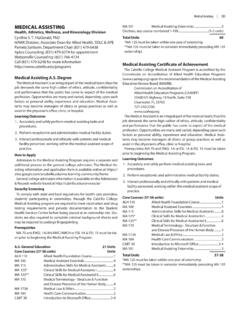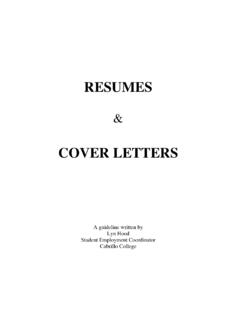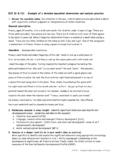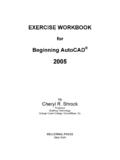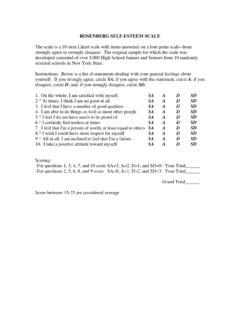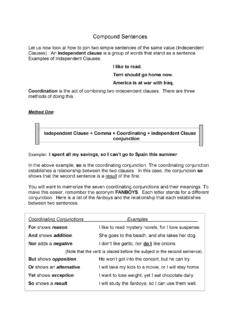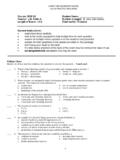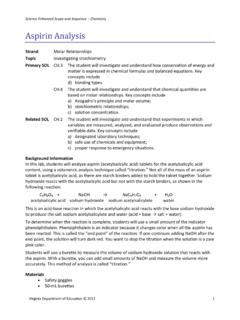Transcription of Calculations and Chemical Equations Example: …
1 1 Calculations and Chemical EquationsAtomic mass : mass of an atom of an element, expressed in atomic mass units Atomic mass unit (amu): x 10-24gAtomic weight:Average mass of all isotopes of a given element; listed on the periodic tableExample:Hydrogen atomic weight = amuCarbon atomic weight = amuCarbon atoms are 12 times as massive as hydrogen atomsPractice:Ca atomic mass = amuNe atomic mass = amuHow many Neon atoms are required to give the same mass as one calcium atom?Avogadro s Number: The Mole1 Dozen = 121 Gross = 1441 Mole = x 10231 mole of atoms = x 1023 atoms1 mole of molecules = x 1023 moleculesMolar mass : the mass (in grams) of one mole a particular substanceThere is a unique relationship between molar mass and atomic weight:Oxygen s atomic weight is amu. 1 mole of oxygen is x 1023 atoms of oxygen1 amu = x 10-24gWhat is the molar mass (g/mole) of oxygen?
2 Amu/oxygen atom x x 10-24g/amu= x 10-24g/atom x x 1023 atoms/mole= g/moleMolar mass (in grams) is alwaysequal to the atomic weight of the atom!Molar mass (in grams) is alwaysequal to the atomic weight of the atom!Examples: Atomic weight of carbon is mass of carbon is g/molAtomic weight of helium is amuMolar mass of helium is g/molMole (mol): The number of particles (atoms or molecules) in a sample of element or compound with a mass in grams equal to the atomic (or molecular) weightExample:Atomic weight of sodium = g of sodium contains 1 mole ( x 1023) of atoms2 Calculations Using the Mole1 mole represents the mass of a samplethat contains Avogadro s number of particlesExample: Atomic wt. of Potassium (K)= 39 amu1 mol K atoms = x 1023atoms = 39 g KExample: Atomic wt. of Sulfur (S) = 32 u1 mol S atoms = x 1023atoms = 32 g S1 mol S atoms = x 1023atoms = 32 g S1 mol S atoms = 32 g SPractice: 1 mol S atoms = x 1023atoms = 32 g S1 mol S atoms = 32 g SWhat is the mass in grams of 1 atom of Sulfur?
3 1 S atom= g1 S atom x 32 g x 1023atoms = g1 S atom = x10-23g Practice: 1 mol S atoms = x 1023atoms = 32 g S1 mol S atoms = 32 g SHow many moles of Sulfur in grams? = moles x 1 mole/32g = moles sulfur= moles sulfurPractice: 1 mol S atoms = x 1023atoms = 32 g S1 mol S atoms = 32 g SHow many atoms in this sample of of S? = atoms of x =atoms of S= SPractice: 1 mol S atoms = x 1023atoms = 32 g S1 mol S atoms = 32 g SWhat is the mass of 1 atom of Sulfur?1 atom= g1 atom x 32 atoms = g= x10-23g SThe mole concept applies to molecules, as well as to atomsChemical formulas indicate relative quantities of atoms within acompoundExample: H2O has 2 H atoms for every 1 Oxygen atomC6H12O6 has how many atoms of each element?3 Formula Weight ( ): sum of all atomic weights of all atoms in a compound; expressed in amuA mole of a molecule will have a mass in grams equal to its formula of CH4N2O (urea) = ?
4 Atomic weights: C = 12 amuH = 1 amuN = 14 amuO = 16 CH4N2O = 12 + 4 (1) + 2 (14) + 16 = 60 amuMolar mass of CH4N2O is 60 g/molPractice:Formula weight of H2O = ? of H2O = atomic weight of H atoms + atomic weight of O atomAtomic weight of H =1amu, O =16 of H2O =Molar mass of H2O = 18 amu18 g/molMore Practice:Prozac, C17H18F3NO, is a widely used antidepressant that inhibits the uptake of serotonin by the brain. What is the molar mass of Prozac?309 g/mole17C ( ) + 18H ( ) + 3F ( ) + 1N ( ) + 1 O ( ) =204 + 18 + + + = Chemical EquationsChemical Reaction:Interaction between substances that results in one or more new substances being producedExample:hydrogen + oxygen waterReactants of a Reaction:Starting materials that undergo Chemical change; written on the leftside of the equation representing the reactionProducts of a Reaction:Substances formed as a result of the reaction.
5 Written on the rightside of the equation representing the reactionThe arrow points towards the products formed by the reactionIndividual products and reactants are separated by a plus sign Chemical Equation: A written statement using symbols and formulas to describe the changes that occur in a reactionExample:2H2(g) + O2(g) 2H2O (l)Letter in parentheses indicates the state of the substance: gas(g), liquid (l), solid (s), dissolved in water (aq)If heat is required for the reaction to take place, the symbol is written over the reaction arrowTypes of Chemical ReactionsCombination Reactions:Reaction in which 2 or more substances react to form a single substanceDecomposition Reactions:Reaction in which a single substance reacts to form 2 or more simpler substancesSingle-Replacement Reactions:Reaction in which an element reacts with a compound and displaces another element from the compoundDouble-Replacement Reactions:Reaction in which 2 compounds react and exchange partners to form 2 new compounds4 Precipitation Reactions:Reaction in which Chemical change results in formation of one or more insoluble productAcid-Base Reactions:Reactions involving the transfer of a hydrogen ion, H+, from one reactant to anotherRedox Reactions: Reaction in which substances undergo oxidation and reduction.
6 Involve the transfer of electrons from one reactant to anotherOxidation:loss of electronsReduction:gain of electronsCombination reaction: two or more elements or compounds combine to form + B ABExamples:H2+ Cl22 HCl2S + 3O22SO34Fe + 3O22Fe2O3 Decomposition reaction: one substance is broken down (split) into two or more simpler + BExamples:2 HgO2Hg + O22 KClO32 KCl + 3 O2 Single replacement reaction: one element takes the place of an element in a reacting compoundA + BC AC + BExample:Zn(s) + HCl(aq) ZnCl2(aq) + H2(g)ZnHClH2 ZnCl2 Double replacement reaction: two elements swap places among the reactants (the positive ions in the reacting compounds) AB + CD AD + CBExamples:AgNO3+ NaClAgCl + NaNO3 ZnS+ 2 HClZnCl2+ H2 SCombustion reaction:a reactant (often containing carbon) reacts with oxygen O2.
7 Examples:C + O2CO2CH4 + 2O2CO2 + 2H2OC3H8+ 5O23CO2+ 4H2O5 Oxidation and Reduction Reactions An oxidation-reduction reaction involves the transfer of electronsfrom one reactant to another. In oxidation, electrons are lost ZnZn2+ + 2e-(loss of electrons--LEO) In reduction, electrons are ++ 2e-Cu (gain of electrons--GER)Identify each of the following as an oxidation or a reduction reaction:A. SnSn4+ + 4e-B. Fe3+ + 1e-Fe2+C. Cl2+ 2e-2Cl-Practice:OxidationReductionReduct ionBalanced Equation: Equation in which the number of atoms of each elementin the reactants is the same as the number of atoms of that element in the productsLaw of Conservation of mass :Atoms are neither created nor destroyed in Chemical reactionsExample:CaS + H2O CaO + H2 SReactantsProductsIs this equation balanced? Example: NO(g) + O2(g) NO2(g)Is this equation balanced?
8 Adjust the coefficient of the reactants and products to balance the equation2NO + O2 2NO2 Reactants ProductPractice:SO2+ O2 SO3Is this equation balanced?Practice:H2+ Cl2 HClIs this equation balanced?2SO2+ O2 2SO3H2+ Cl2 2 HCl6 Chemical Equations and the MoleStoichiometry:Study of mass relationships in Chemical reactions; ratiosof different moleculesExample: CH4+ 2O2 CO2+ 2H2O10 CH4+ 20 O2 10 CO2+ 20 x1023 CH4+ x1023 O2 x1023 CO2+ x1023 H2O1 mol CH4 + 2 mol O2 1 mol CO2+ 2 mol CH4+ O2 CO2+ x1023 CH4+ x1023 O2 x1023 CO2+ x1023 H2O1 mol CH4 + 2 mol O2 1 mol CO2+ 2 mol CH4+ O2 CO2+ many moles of O2 would be required to react with mol CH4? mol CH4= mol mol CH4x 2 mol O2/1 mol CH4= mol O2 How many grams of H2O will be produced from mol of CH4?2-part problem: first find moles of H2 Othen convert moles to gramsUse this equation to obtain conversion factor for moles of CH4to moles of H2O:1 mol CH4 + 2 mol O2 1 mol CO2+ 2 mol mol CH4= mol mol CH4x 2 mol H2O/1 mol CH4= mol mol H20 = grams mol H20 x H2O/1 mol H2O = H2 OTheoretical and Percent YieldTheoretical yield: the maximum amount of product that would be formed from a particular reaction in an idealworldActual yield:the amount of product formed from a particular reaction in the realworld (usually lessthan the theoretical yield)Percent yield:ratio of actual yield to theoretical yield, times 100 %% yield = actual yield/theoretical yield x 100% example : theoretical yield = wateractual yield = g water% yield = x 100% = % yiel

